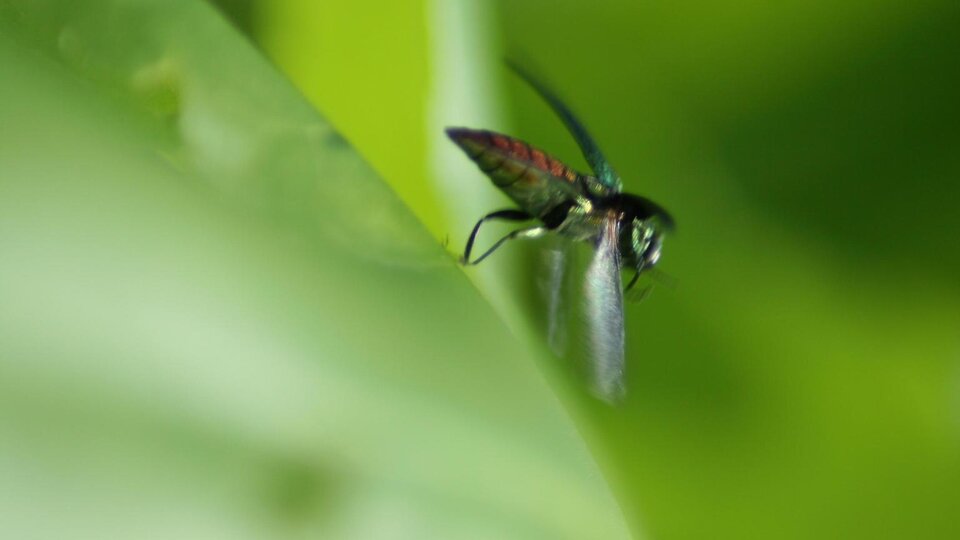Photo: An adult emerald ash borer flying off of a tree leaf.
Credit: Jared Spokowsky, Indiana Department of Natural Resources, Bugwood.org
General Information
Species Name: Agrilus planipennis
Also Known As: EAB
Family: Buprestidae (jewel beetles or metallic wood-boring beetles)
Life Cycle: Complete (egg > larvae > pupae > adult). The larvae stage is the most destructive life cycle stage because they feed under the bark of ash trees for 1-2 years. They specifically feed on the parts of the tree where nutrients and water are transferred through the tree itself.
Activity: Adults emerge in Nebraska mid-May through early August.
Origin: China and parts of East Asia
Why Is It Invasive?
There are many native wood-boring insects found in Nebraska that attack many trees and shrubs in the landscape. What sets EAB apart, however, is that it will attack almost strictly ash trees and go after healthy and stressed trees alike. Nebraska has a high percentage of ash trees and losing such a large number of the tree population has the potential for long-lasting effects. Ash trees in Nebraska that are susceptible to EAB include: White ash (Fraxinus americana), green ash (Fraxinus pennsylvanica) and black ash (Fraxinus nigra). An alternative host has also been identified as the white fringetree (Chionanthus virginicus).
What Does It Look Like?
General Characteristics
Adult Beetle
The adult beetle is small, roughly the size of a grain of rice, and metallic emerald-green in color with a coppery red underside.
Larvae
The larvae are white to cream-colored, legless, and have a segmented body. They are typically found under the bark of infested trees.
Pupal Stage
The pupae are cream-colored and found in the larval galleries just beneath the bark.
Photos
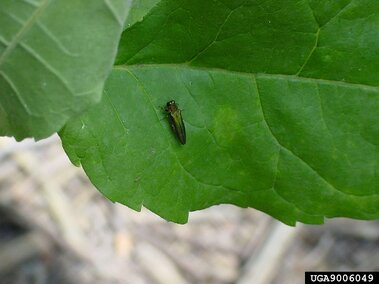
Photo: An adult emerald ash borer on a tree leaf.
Credit: Brian Sullivan, USDA APHIS PPQ, Bugwood.org
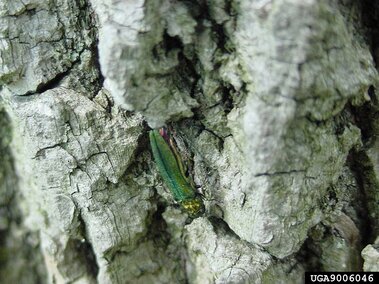
Photo: An adult emerald ash borer on the bark of an ash tree.
Credit: Brian Sullivan, USDA APHIS PPQ, Bugwood.org
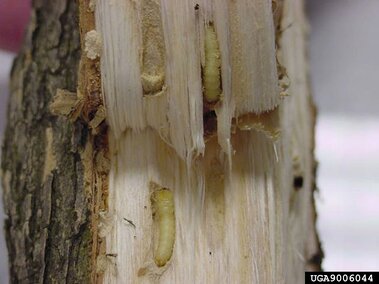
Photo: Two emerald ash borer larvae nestled into feeding holes they created underneath an ash tree's bark.
Credit: Brian Sullivan, USDA APHIS PPQ, Bugwood.org
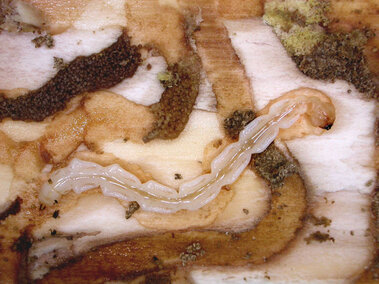
Photo: A nearly mature emerald ash borer larva feeding on an ash tree's cambium (layer of tissue between the outer surface bark and inner bark).
Credit: David Cappaert, Bugwood.org
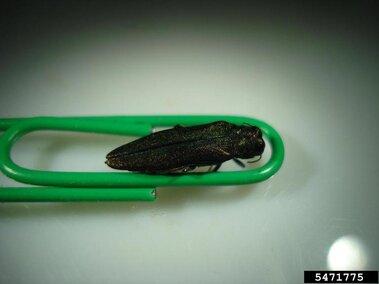
Photo: An adult emerald ash borer on a paper clip for scale.
Credit: Kenneth R. Law, USDA APHIS PPQ, Bugwood.org
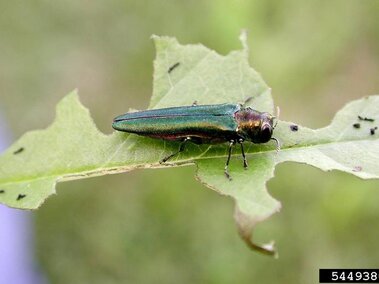
Photo: An adult emerald ash borer feeding on an ash tree leaf.
Credit: Debbie Miller, USDA Forest Service, Bugwood.org

Photo: Varieties of emerald ash borer insects at different growth stages to demonstrate their life cycle. Early pupae stages are shown on the left and adult stages are shown on the right.
Credit: Debbie Miller, USDA Forest Service, Bugwood.org
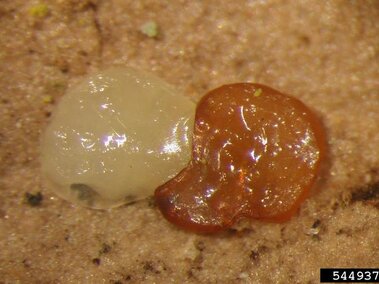
Photo: The eggs of emerald ash borer are laid on ash trees in bark crevices or between bark layers. The eggs are white (left) when first laid, but soon turn an amber color (right).
Credit: Debbie Miller, USDA Forest Service, Bugwood.org
What Are The Signs of Infestation?
D-shaped Exit Holes
Adult beetles emerge from the tree through small, D-shaped holes about 1/8 inch (3 mm) in diameter.
S-shaped Galleries
The larvae create serpentine galleries under the bark, which disrupt nutrient and water transport, leading to tree decline.
Dieback
The canopy of infested ash trees may show thinning, yellowing, and dieback, starting from the top of the tree and progressing downward.
Bark Cracks
The bark may start to split or exhibit cracks as the tree reacts to the damage.
Excessive Sprouting
Ash trees may develop many small shoots or sprouts on the trunk and lower branches as a response to stress.
Woodpecker Activity
Increased woodpecker activity is often a sign, as they feed on the larvae under the bark.
Photos
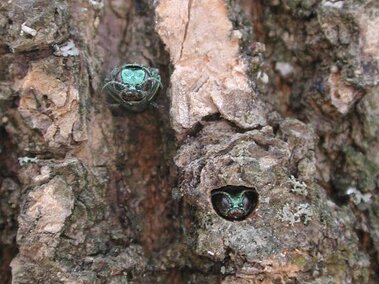
Photo: Two adult emerald ash borers emerging from d-shaped exit holes in an infected tree.
Credit: Debbie Miller, USDA Forest Service, Bugwood.org
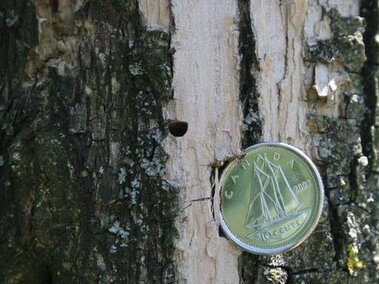
Photo: Close-up of a d-shaped exit hole made by an adult emerald ash borer next to a Canadian coin for scale.
Credit: Troy Kimoto, Canadian Food Inspection Agency, Bugwood.org
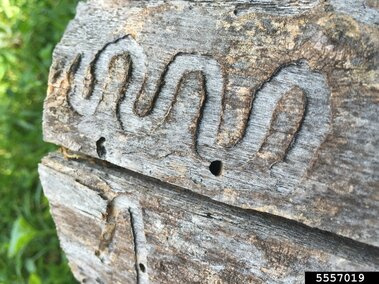
Photo: S-shaped tracks made by emerald ash borer larvae in an ash tree with their d-shaped exit holes to emerge as adults.
Credit: Elizabeth McCarty, University of Georgia, Bugwood.org

Photo: S-shaped tracks made by emerald ash borer larvae underneath an ash tree's bark.
Credit: Joseph OBrien, USDA Forest Service, Bugwood.org
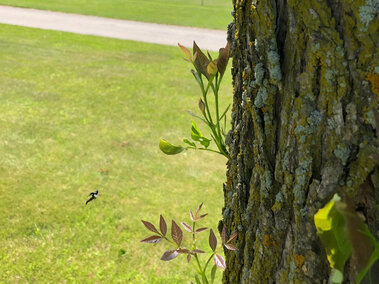
Photo: An ash tree resprouting in several places from its bark due to stress caused by emerald ash borer infestation.
Credit: Bill McNee, Wisconsin Dept of Natural Resources, Bugwood.org
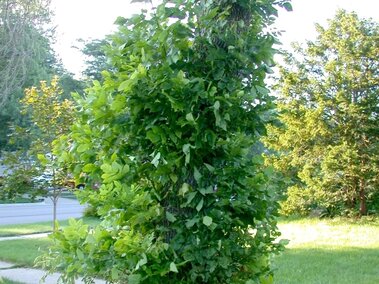
Photo: Excessive sprouting from an ash tree due to stress caused by emerald ash borer infestation.
Credit: Pennsylvania Department of Conservation and Natural Resources - Forestry , Bugwood.org
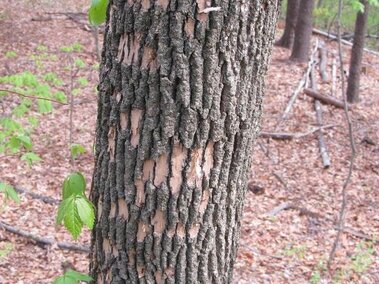
Photo: Cracks and chipping on an ash tree's bark caused by emerald ash borer infestation damage.
Credit: Kenneth R. Law, USDA APHIS PPQ, Bugwood.org
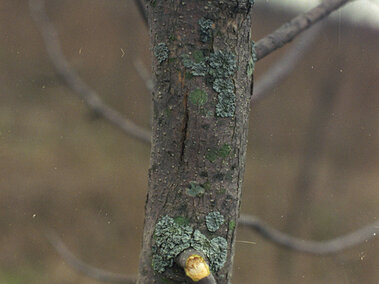
Photo: Bark cracks in an ash tree caused by emerald ash borer feeding.
Credit: Troy Kimoto, Canadian Food Inspection Agency, Bugwood.org
Where Do They Live?
EAB larvae feed almost exclusively on ash trees, so they can be found anywhere there is an ash tree. The adult female beetle will lay eggs during the summer months on the bark of ash trees. Approximately 14 days later, the eggs will hatch, and the larvae will immediately chew their way under the bark into the tree. It will feed there for at least a year before emerging from underneath the bark.
How Do They Spread?
Adult EAB beetles will stay within a half mile from where they emerged, so much of the spread is attributed to humans, mostly from moving firewood that is infested from one area to another. Additionally, any other wooden packing material, such as pallets, can unknowingly be infested and moved longer distances that the beetle itself wouldn’t travel.
What Do I Do If I Find Them?
The federal and state EAB quarantines have been lifted, so EAB is no longer a pest of regulatory concern. However, EAB movement is still being tracked across Nebraska. If you find what you believe is EAB, please email the Nebraska Department of Agriculture at agr.plant@nebraska.gov, or report them to the Nebraska Forest Service here.
How Do I Control Them?
Mechanical
Follow recommendations from the Nebraska Department of Agriculture to reduce the spread of EAB in potentially-infested ash wood.
Cultural
Don't move or transport firewood from infested areas to reduce the spread of EAB. Firewood can harbor larvae and facilitate the spread of the pest. Consider planting tree species that are not susceptible to EAB as replacements for ash trees in your landscape. Maintain the overall health of ash trees with proper watering, fertilization, and pruning to help them withstand the stress caused by EAB. In severe cases, remove and properly dispose of heavily infested ash trees to prevent further spread of EAB. Ensure that the wood is chipped or burned to kill any remaining larvae.
If you suspect a severe infestation or if the tree is large and difficult to manage, consult with an arborist or pest management professional for advice on the best course of action. For detailed assessment of tree health and appropriate treatment options, professional evaluation can help ensure that the correct measures are taken.
Herbicide
Please refer to the 2025 Guide for Weed, Disease and Insect Management in Nebraska, contact your county weed control authority, or find a certified Nebraska arborist.
References and More Information
Center for Invasive Species and Ecosystem Health
Nebraska Department of Agriculture
